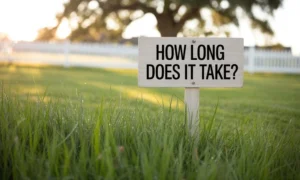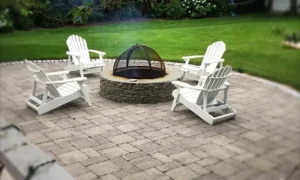French drain installation is a practical and effective solution for managing excess water on your property. Whether you’re dealing with standing water, surface water issues, or water damage in your basement, installing a French drain can protect your home and landscape. This guide will walk you through everything you need to know about French drains, their benefits, types, installation, and maintenance.
What Is a French Drain?
A French drain is a drainage system designed to redirect water away from areas where it might cause damage. It consists of a trench filled with gravel or rock and a perforated pipe that channels water to a safe outlet. The system effectively manages drainage problems and prevents surface water or groundwater from accumulating.

When and Why You Need a French Drain
When to Install a French Drain
- Persistent standing water in your yard.
- Water pooling near your home’s foundation.
- Drainage problems in your driveway or landscaping.
- Water damage or moisture issues in your basement or crawl space.
Why You Need a French Drain
- Protects your foundation from water damage.
- Prevents erosion in landscaped areas.
- Redirects water from problem areas to avoid costly repairs.
- Reduces reliance on sump pumps for managing interior water issues.
Types of French Drains
There are several types of French drains, each designed for specific purposes.
Surface French Drains
A surface French drain is a shallow drainage system designed to manage surface water effectively. With the expertise of Bay Area landscape design, this system can be seamlessly integrated into your outdoor space, enhancing both functionality and aesthetics. Installed just below the ground, it collects and redirects water away from areas prone to pooling, such as driveways, patios, or low-lying spots. Bay Area landscape design professionals ensure the trench, filled with gravel and a perforated pipe, is properly installed to channel water away, preventing erosion, flooding, or water damage. This practical solution improves water flow and protects outdoor spaces, keeping your property dry and well-maintained.

Subsurface French Drains
Subsurface French drains are underground drainage systems designed to manage groundwater effectively. Installed deeper than traditional surface drains, they help redirect water away from areas prone to flooding, such as basements. These drains typically consist of perforated pipes surrounded by gravel or sand, which allow water to flow into the pipe while filtering out debris. By channeling excess groundwater to a safe discharge point, subsurface French drains prevent water from seeping into building foundations or basements, reducing the risk of structural damage and mold growth. They are a practical solution for areas with high water tables or persistent drainage issues.
Curtain Drains
Curtain drains are a hybrid drainage system designed to intercept and redirect water flow before it reaches a targeted area. They are particularly effective for protecting gardens, slopes, and septic systems from water accumulation or erosion. These drains typically consist of a trench filled with gravel and a perforated pipe that collects and channels water away from vulnerable areas. By preventing water from saturating the soil, curtain drains help maintain structural integrity, promote proper drainage, and protect landscaping features. Ideal for managing surface and shallow subsurface water, they are a practical solution for areas prone to excessive moisture or runoff.
Choosing the Right Type
Selecting the right French drain depends on the drainage challenges specific to your property. For minor surface water issues, a shallow French drain might suffice, while deeper systems are ideal for addressing significant groundwater problems. Understanding soil type, water flow patterns, and landscaping can influence the choice. Consulting drainage professionals is crucial, as they can assess your property’s conditions and recommend the most effective solution. They ensure the system is designed and installed properly, preventing future issues. Investing time in selecting the correct type of French drain guarantees optimal performance, protecting your property from water damage and enhancing durability.
Advantages of Installing a French Drain
Prevents Water Damage
A French drain is an effective solution to prevent water damage and protect your home’s structure. By directing excess water away from your property, it minimizes the risk of water infiltration that can lead to cracks, mold, and foundational issues. Installed in areas prone to pooling water, this drainage system collects and redirects water through a perforated pipe surrounded by gravel. This proactive measure safeguards your basement, walls, and foundation from moisture-related problems, ensuring long-term durability. Whether from heavy rainfall or groundwater buildup, a French drain keeps your home dry and secure, preventing costly repairs and preserving structural integrity.
Cost-Effective Solution
A French drain is a cost-effective way to address drainage issues without breaking the bank. Unlike costly landscaping overhauls or extensive foundation repairs, installing a French drain provides a practical and affordable solution. It works by redirecting water away from areas prone to pooling or flooding, protecting your property from water damage. The installation process is relatively straightforward and involves less disruption than other methods, keeping labor and material costs manageable. By preventing long-term issues like soil erosion or foundation damage, a French drain offers a proactive, budget-friendly approach to maintaining the health and stability of your property.
Versatility
French drains are highly versatile and can be adapted to suit different needs. They efficiently manage water in various settings, such as preventing basement flooding with interior French drains or directing runoff away from homes. For driveways, they control excess water, reducing erosion and ensuring a stable surface. Their design can be customized based on the location, drainage volume, and specific requirements, making them an ideal solution for residential and commercial properties. Whether addressing yard drainage, protecting foundations, or managing water near driveways, French drains offer a flexible, reliable approach to water control in diverse environments.
Improves Landscaping
Improving drainage is essential for enhancing your landscape design. Proper drainage prevents waterlogging, which can damage plants, grass, and soil structure. It ensures that excess water flows away from your garden, avoiding erosion and puddling that harm the aesthetics and usability of your outdoor spaces. With effective drainage systems, such as French drains or strategically placed channels, you can maintain healthy plant roots and reduce the risk of diseases caused by standing water. Additionally, well-drained landscapes are easier to maintain and more visually appealing, creating a polished and functional outdoor area that complements your property while promoting environmental sustainability.
How to Install a French Drain: Step-by-Step Guide
Tools and Materials Needed
- Shovel or trenching tool
- Landscape fabric
- Perforated pipe
- Gravel
- Drainage piping
- Measuring tape
- Level for ensuring slope
Preparing the Site
Preparing the site for drainage involves first identifying areas prone to water accumulation, such as low-lying spots or places where water tends to pool. Inspect the landscape for any areas with inadequate drainage that could lead to erosion or water damage. Once problem areas are identified, plan the trench layout strategically to guide water flow away from the affected areas. The trench should be positioned to create a downward slope, directing water towards a drainage system or suitable runoff area. Proper planning ensures efficient water management and prevents long-term damage to the landscape or structure.
Digging the Trench
To begin the installation process, dig a trench with the appropriate depth and width to accommodate your chosen drainage or piping system. The trench should be deep and wide enough to fit the pipes or materials comfortably. It’s essential to ensure that the trench slopes downward at a slight angle to allow proper water flow. This slope prevents water from pooling or backing up in the system, ensuring effective drainage. The ideal slope typically ranges from 1% to 2%, meaning for every 10 feet of trench, it should drop 1 to 2 inches to encourage smooth water movement.
Adding Gravel
To begin, add a layer of gravel at the bottom of the trench. This layer helps with drainage by allowing water to flow freely through the soil and prevents the trench from becoming waterlogged. Next, place a piece of landscape fabric over the gravel. The fabric serves as a barrier to prevent soil and debris from mixing with the gravel, which could clog the drainage system. It also helps maintain the gravel’s effectiveness over time, ensuring proper water flow and preventing blockages. This step is essential for maintaining the longevity and functionality of your drainage system.
Installing the Pipe
To install the pipe, first dig a trench where the pipe will be placed. Lay the perforated pipe in the trench, making sure the holes are positioned facing downward. This orientation allows the pipe to effectively collect water from the surrounding soil. The perforations allow water to enter, while the downward-facing holes ensure that gravity helps direct the water into the pipe, preventing pooling or backup. It’s important to check the pipe’s alignment to maintain proper water flow and ensure the system works as intended. Finally, cover the pipe with soil, ensuring it stays securely in place.
Covering and Finishing
To properly cover and finish a pipe installation, start by placing a layer of gravel around the pipe. This helps with drainage and prevents soil from blocking the pipe. Next, fold landscape fabric over the gravel to create a barrier that prevents dirt or other materials from infiltrating the gravel layer. Finally, cover the fabric with soil or decorative rocks, depending on the desired appearance. This process ensures the pipe is well-protected, improves drainage, and gives the area a finished, aesthetically pleasing look while maintaining functionality.
Common Applications for French Drains
French Drain Driveways
A French drain driveway effectively redirects water away from driveways, preventing pooling and erosion. This drainage system consists of a trench filled with gravel and a perforated pipe that collects and channels excess water to a designated drainage area. It is ideal for driveways prone to water accumulation, as it minimizes surface water damage and protects the driveway’s structure over time. By improving water flow, French drains help maintain the stability of the surrounding soil and reduce the risk of cracks or potholes. They are a practical and efficient solution to keep driveways safe, dry, and long-lasting.
Interior French Drains
Interior French drains are installed within basements to effectively manage water seepage problems. These systems consist of a perforated pipe placed at the base of a basement wall, typically beneath the floor slab. The drain collects water that seeps through walls or rises from the ground and channels it to a sump pump, which then expels it away from the property. Interior French drains are ideal for homes where exterior drainage solutions are impractical or insufficient. They prevent flooding, reduce moisture buildup, and protect the basement from structural damage, creating a drier and healthier environment. Installation is efficient and minimally invasive.
Yard and Garden Drainage
Yard and garden drainage systems are essential for preventing water from pooling in outdoor spaces. By directing excess water away from areas like lawns, flower beds, and pathways, they help avoid waterlogging, which can damage plants and lead to soil erosion. Proper drainage also promotes healthier soil by preventing compaction and improving air circulation, allowing plant roots to grow more freely. Additionally, well-managed drainage systems reduce the risk of pests and mold growth, creating a more pleasant and sustainable outdoor environment while protecting your landscaping investments. Overall, effective drainage ensures optimal plant health and soil vitality.
Common Installation Mistakes to Avoid
- Insufficient slope in the trench.
- Using the wrong type of pipe for the application.
- Skipping the landscape fabric, leading to clogged drains.
- Not properly compacting the gravel layer.
Cost of French Drain Installation
The cost of a French drain varies depending on size, materials, and labor. On average:
- Expect to pay $1,000–$3,000 for a basic system.
- Driveway systems or interior French drains can cost more due to complexity.
Labor costs and material prices, such as those at Menards, will influence the total expense.
Why Choose Us?
At Lakota Design Group, we specialize in professional French drain installation services tailored to your unique needs. Our team ensures efficient solutions, quality materials, and expert craftsmanship to resolve your drainage problems effectively.
Benefits of Choosing Lakota Design Group:
- Experienced professionals with years of expertise.
- Customized drainage systems to protect your home.
- Transparent pricing with no hidden fees.
- Commitment to customer satisfaction.
Conclusion
French drain installation is an essential solution for managing water damage, improving landscaping, and ensuring a safe and dry environment for your home. By understanding the types, advantages, and installation process, you can make an informed decision about protecting your property.
For expert help with your drainage system needs, contact Lakota Design Group today and let us take care of your French drain installation with precision and care.




















